Life and death in tropical Australia, 40,000 years ago.
Published in Ecology & Evolution
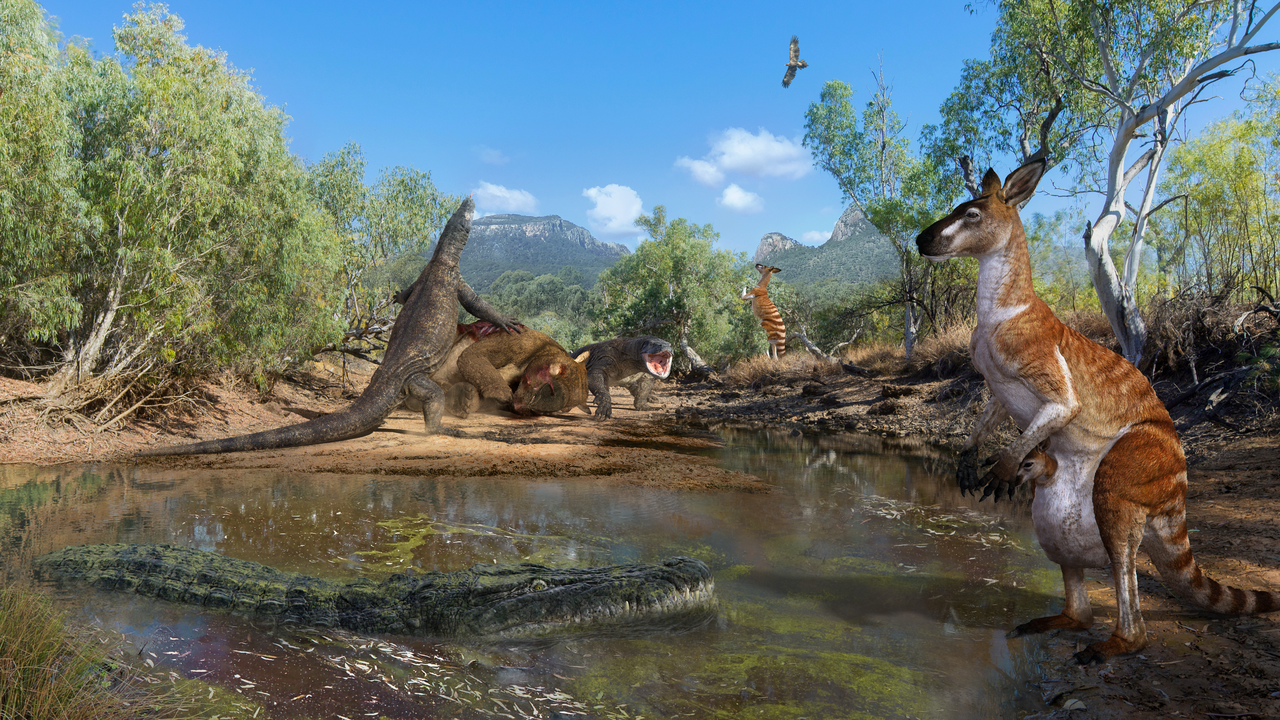
Before I begin this post I would like to acknowledge and pay respect to the traditional owners past and present of the lands of the Barada Barna people on which this study occurred and without whom these stories would not be possible. I thank them for their ongoing guidance and contributions. I would also like to thank the landowners and BHP for providing ongoing access to the fossil sites and support of this work.
As I begin this post I am in partial lock down due to the coronavirus (COVID-19) pandemic. I’m still in the office, thankfully able to continue work, but for how long I do not know. My museum is closed to the public, our education and outreach programs have ground to a halt, my family and friends are struggling, and my parents are stuck on a cruise ship off the coast of South Africa heading to the United Kingdom. The global anxiety and uncertainty about the future is palpable and as I sit here staring at a computer screen next to a bunch of fossilised bones 60,000 to 40,000 years old, it is not lost on me how bizarre this situation is.
As a museum palaeontologist whose subjects are fossils, and whose key aim is in the documentation of the past to better understand the present, I cannot help but wonder what messages these specimens are telling me. In the context of the multiple crises we face today, from climate change, to habitat loss and species extinction, and now viral pandemic, the future of the human species is clearly vulnerable. The Australian continent has certainly felt this recently, from a summer of catastrophic fires, to flash flooding and now disease. But as one of the Earth’s oldest continents, Australia has seen its fair share of cataclysmic life-changing events through time. They happened with or without us humans as part of its landscape, across eons of evolution and extinction.
To many, a bunch of old bones would seem like poorly chosen prophets of the future. Some may think they are so far removed in time to our present to serve little or no relevance to our current situation. And to be frank, I would agree with them right now. A bunch of old fossils can’t bring my mum and dad home quicker, or stop the march of a virus. But long after the current crisis ends these old bones will still be here telling their unique stories, albeit at a safe 1.5-2 m distance! Their stories sit alongside the millions of others that have survived past droughts and floods, literally for thousands and millions of years. They've also survived past pandemics and World Wars spanning the last 158 years since they became scientific specimens. Such survivors need protection, so they can tell their stories for future generations.
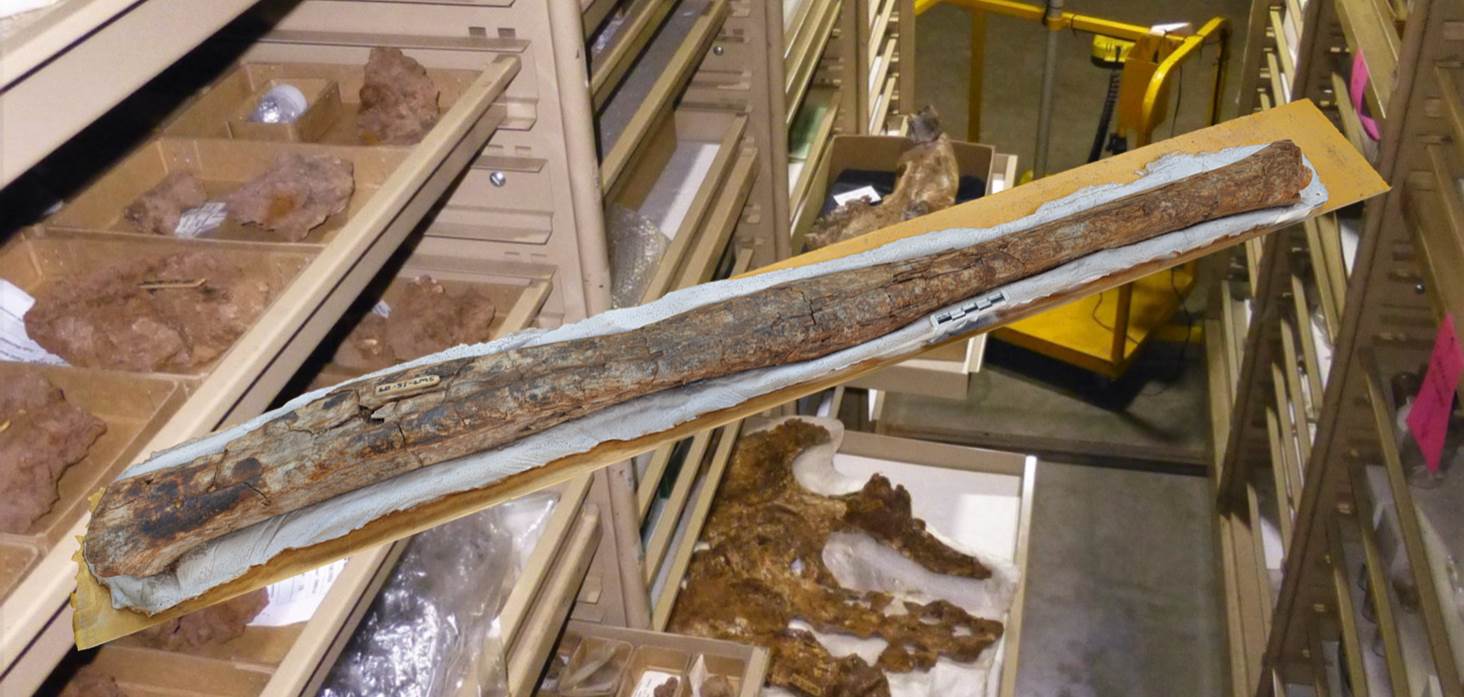
The Queensland Museum Geosciences Collection is one of the largest in the Southern Hemisphere and holds the fossils that come from our newly published Tropical Megafauna site - you can see it in 3-D here. Image Credit: Scott Hocknull
Ok, well that escalated quickly! A few paragraphs in and I am now working from home, detached from the very fossils I’m here to tell you about. I set out to write a prophetic story about how our present research into the past informs the present day and how this could help us into the future. This is a common mantra of many palaeontologists, and it is true, that by looking into our past we do see clearly defined periods of global catastrophe, extinction and loss followed by regeneration and adaptation. We can obviously learn from these extinction events. This is no truer than the hotly debated topic of megafauna extinction in Australia, and the suspected role of climate and humans within it. A debate infused with diametrically opposed viewpoints and opinions that dominate an area of research with astoundingly little objective evidence. But perhaps this debate over opinion is an article for another time. Instead, I’d rather tell you about the creatures of this debate, the megafauna.
To me, understanding the lives of megafauna from the continent of Sahul (Australia & New Guinea) during a period when people were occupying it strikes my imagination more than pinning down the smoking gun of their final demise. Their extinction left a continent bereft of a range of giants unlike any other on Earth and with such a poor fossil record to go around, we are still just starting to understand their diversity across this massive continent of ecological extremes.
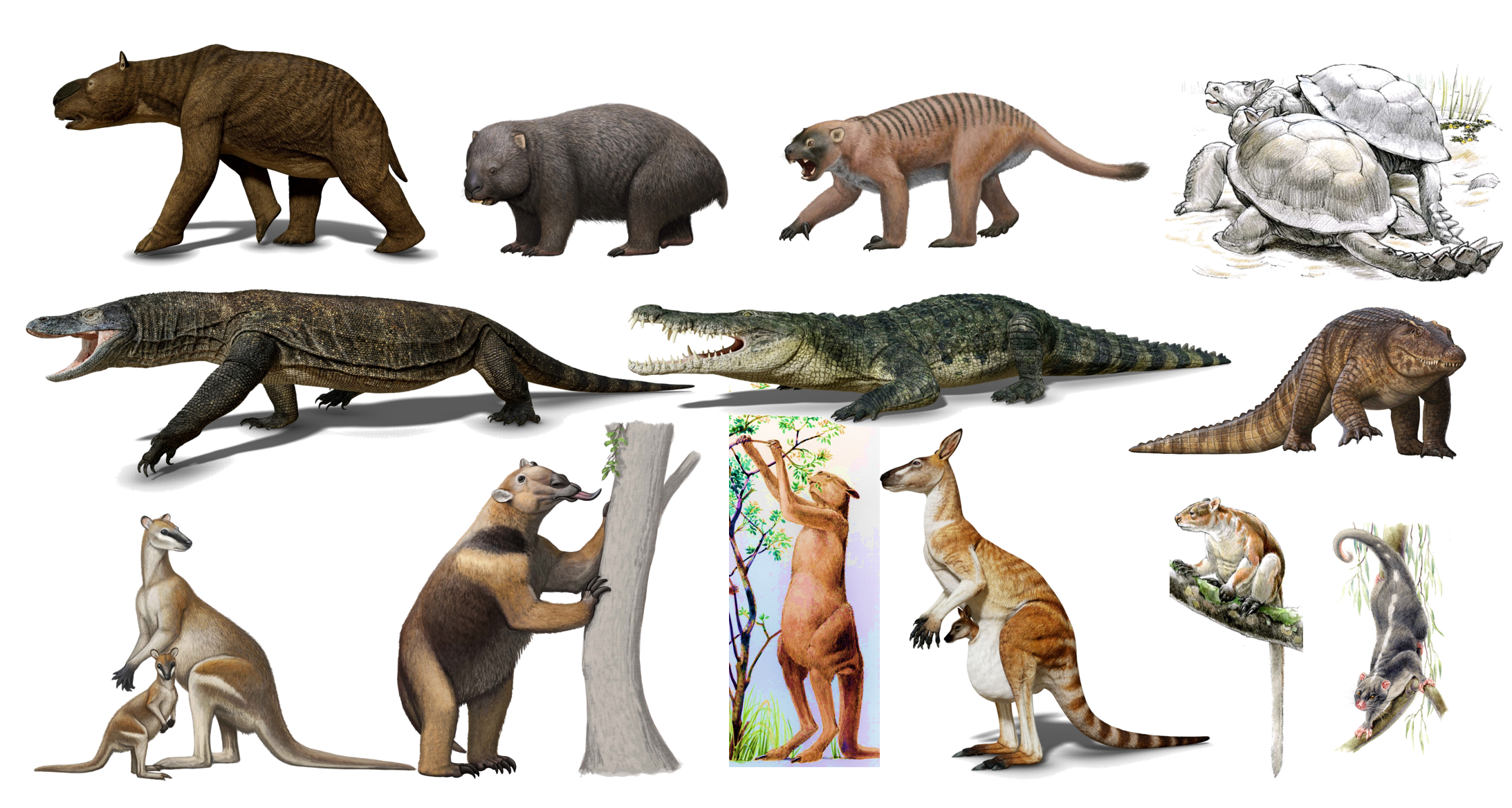
Some of the menagerie of Pleistocene Megafauna from Sahul include bizarre giant mammals, turtles, crocodiles, lizards and birds with many newly discovered species from South Walker Creek. Image Credits: Konstantinov, Atuchin, Allen, Lawrence & Hocknull.
When you look at the period of human occupation of Sahul (~65,000-45,000 years ago), which remains another hotly debated and opinionated point of contention, it is strikingly clear that the megafauna fossil record for this period of time is very poor, I mean exceptionally poor to almost absent across almost two thirds of the continent. This is different for the archaeological record with a near continental-wide spread of sites, albeit still frustratingly limited. But the palaeontological record is seemingly abysmal. This has been known for decades by palaeontologists and archaeologists and during many a megafauna extinction debate this astounding lack of data/evidence has been lamented with calls to ‘find more sites’. Yet even with a well-known lack of evidence the ‘debate’ seems to have ‘moved on’ to big data interpretations. To me, the debate is like propping up a termite-riddled house of cards, where we seem to spend most of our time drawing more cards and not filling in the holes.
From a Queensland perspective, a broad suite of megafauna fossil sites is known from across this data gap. However, with little context or systematic collection, most of these fossils are simply points on a map with no chronology. So the gaping holes in the megafauna dataset remain unfilled, with the tropical climes of northern Australia and along the eastern seaboard suffering this dramatic problem most of all.
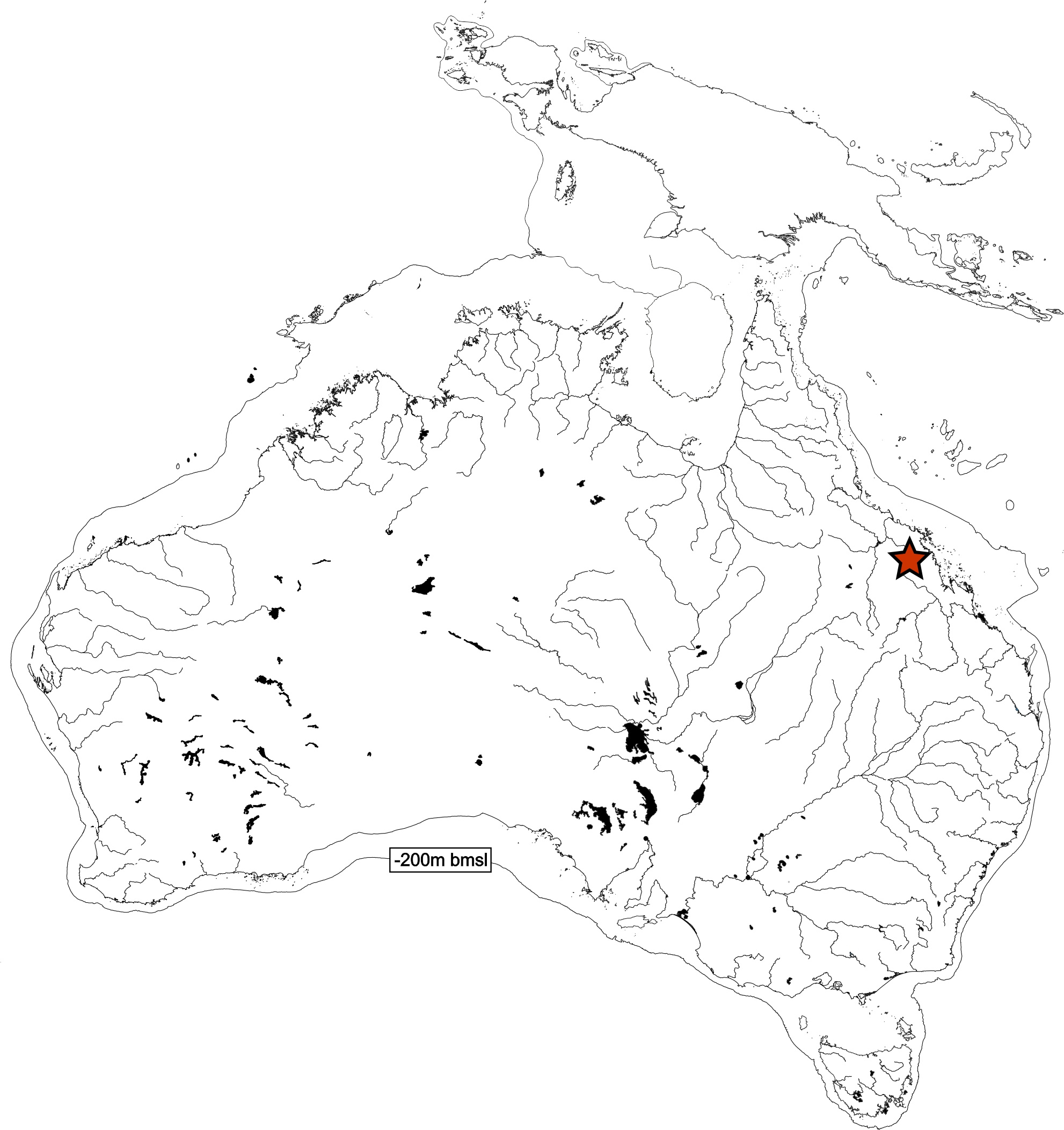
The great continent of Sahul (Australia and New Guinea) has been joined more often than separated over the past million years. South Walker Creek is located in tropical northern Australia, along the eastern seaboard.
When pictures of a handful of weathered fossilised bone fragments came via email in mid-2008 from a site approximately 100kms west of Mackay a decade of ongoing research began to fill one of these gaps. The site was originally discovered by Barada Barna Traditional Owners whilst undertaking a cultural heritage survey of the Walker Creek as part of the South Walker Creek mine plan. Geological mapped as Permo-Triassic, I initially thought it was a very old fossil deposit, perhaps of early proto-dinosaurs and mammal-like reptiles but it was clear from the photos that these fossils were weathering out of Quaternary-aged alluvium thinly draped across the top of the ancient bedrock. I was astounded that such fossils were preserved in such circumstances and in a tropical environment.
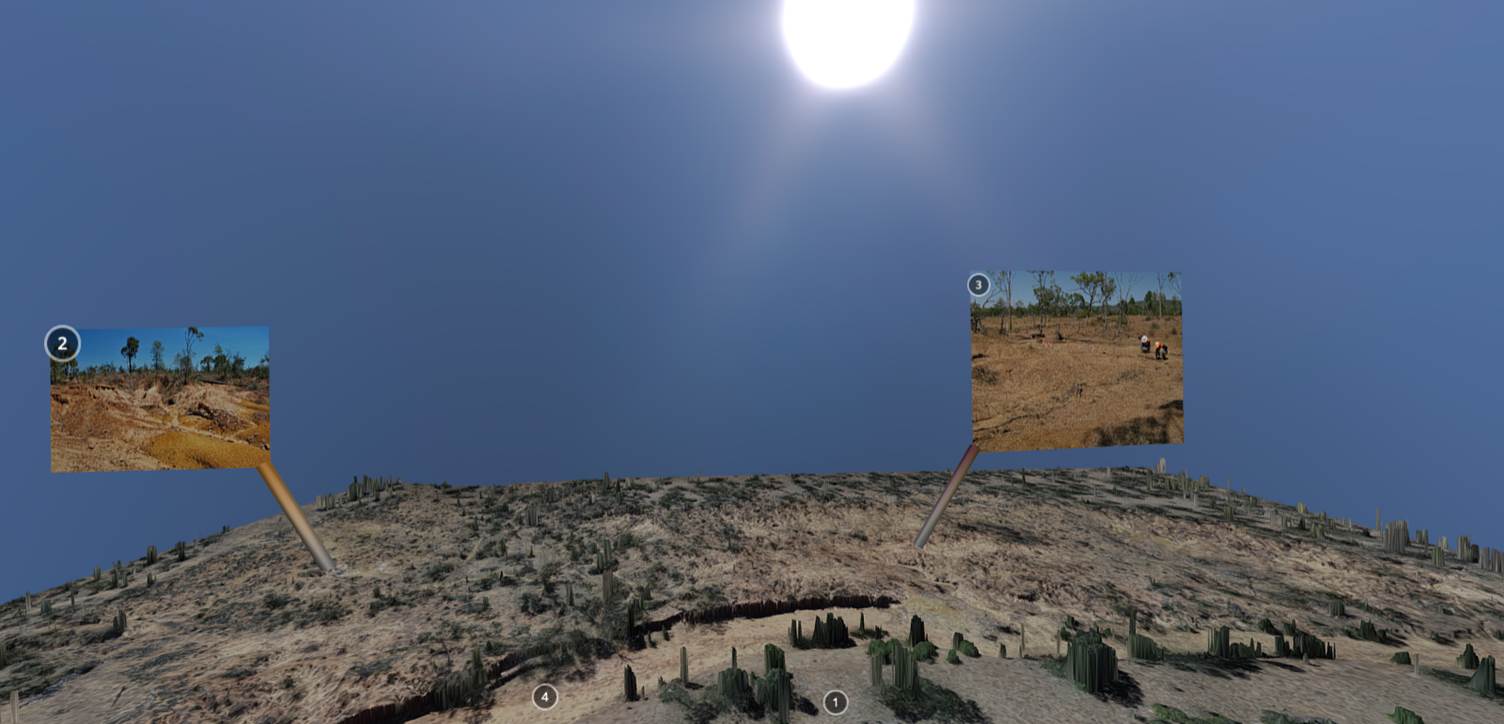
The fossils from South Walker Creek are found in eroded gullies cutting down into an ancient flood plain by the present day Walker Creek - see in 3-D here.
The cultural heritage team recognised the specimens as being fossil bones, but were not sure what they were from because they were heavily weathered bone fragments. One image pictured a crocodilian osteoderm, the bone that sits beneath each scale along the crocodile’s back. This was quite different to osteoderms I was familiar with from the giant extinct freshwater crocodile, Pallimnarchus, but it closely resembled the osteoderms from a Saltwater Crocodile (Crocodylus porosus). Such a find, no matter what the crocodilian species, immediately indicated two significant points. Firstly, at some point in the past the site must have had substantial permanent freshwater and a healthy aquatic ecosystem to sustain such a large apex predator. Whilst looking at the site location on Google Earth, it was apparent that there were very few permanent water bodies within the present day river system, with the exception of Lake Elphinstone at the headwaters of the catchment. This lake and other isolated billabongs alluded to a more permanent watery environment in the recent geological past. What was more striking about the location was that is occurs at the very upper reaches of the Fitzroy River Basin, the largest easterly-draining catchment in Australia - which feeds the southern part of the Great Barrier Reef with nutrients. This was not a location I would have expected to find Quaternary vertebrate fossils. In fact, modelling of Australian Pleistocene fossil sites would suggest there was a close to zero chance of finding fossils anywhere near these locations, and yet here they were.
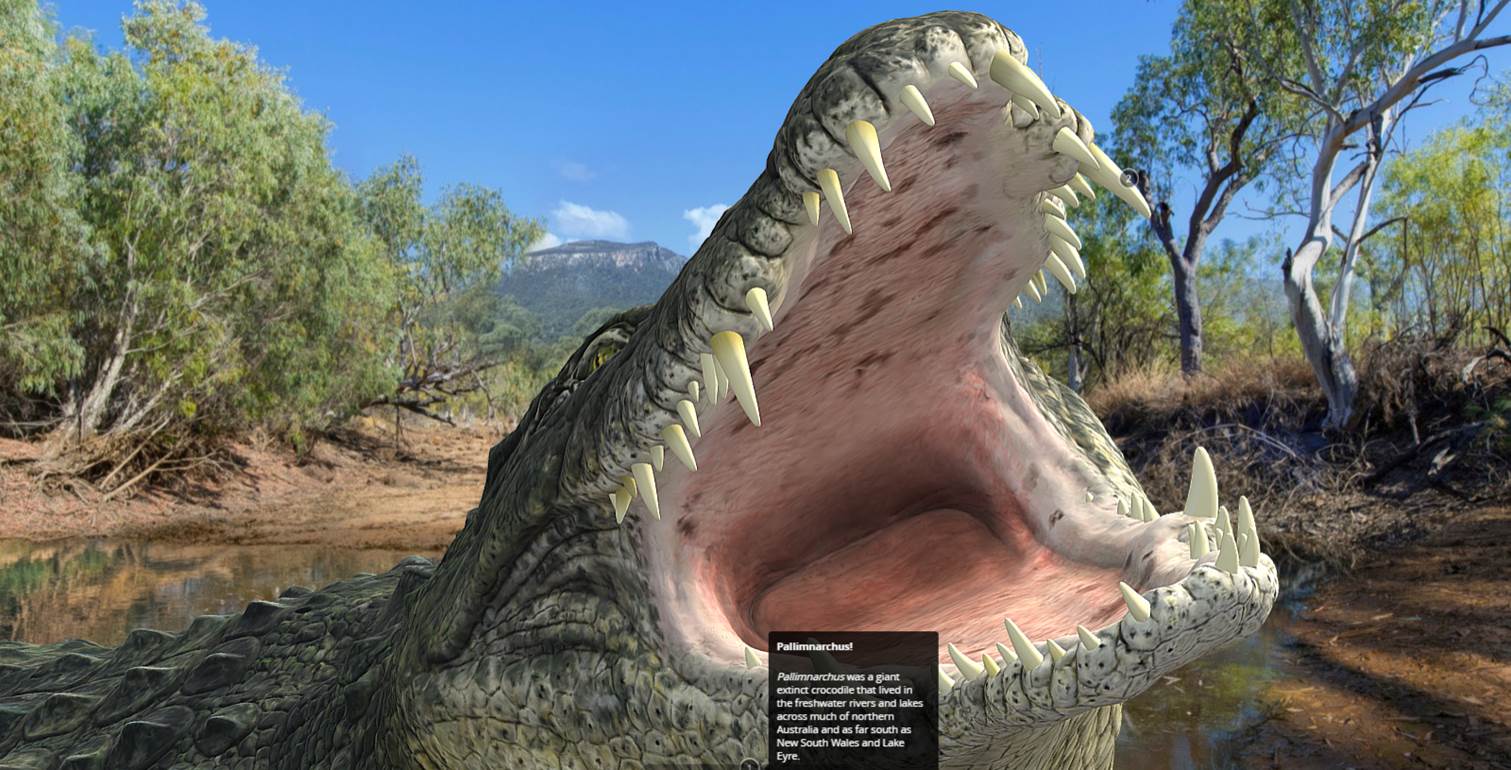
The largest predators in the tropics 40,000 years ago were the aquatic crocodiles, like Pallimnarchus, but the land-dwelling reptiles were equally apex - see them here in 3-D!
In late 2008, a small team represented by myself and two museum volunteers, Noel Sands and Joshua Moulds, took a closer look at the fossil site that had been discovered. We met with mine environmental officers and representatives of the Barada Barna, who were excited to show us the site they had discovered. Once there it became immediately clear to me that this was not a site preserving just a handful of bone fragments. Instead, this one site stretched for over 300m2 and was littered with bones, teeth and other fossils. Immediately the list of species sprung from one crocodilian to a range of megafauna including bones and teeth from giant kangaroos, wombats and lizards. Unfortunately, all were very poorly preserved due to surface weathering from exposure. We spent the next two days surveying a number of kilometres of the South Walker Creek area for other sites. On the last few hours of the last day whilst walking gullies I came across a shining row of large blade-like teeth sticking out of the ground, like a floret, just sitting there waiting to be discovered. My heart skipped a beat; these teeth were from the giant marsupial, Diprotodon. My first ever discovery of a Diprotodon skull and found up a gully no different to the dozen gullies I’d just walked. On closer inspection, this was a very young individual, the teeth were hardly worn. Across the surface of the site dozens of bone and tooth fragments were just poking out of the surface. What made this site special was that the preservation of the bone was near perfect. They had been split up by the fine clay preserving them, but in all other ways, perfect. Dig here! - I exclaimed to no one…I was by myself at the time.
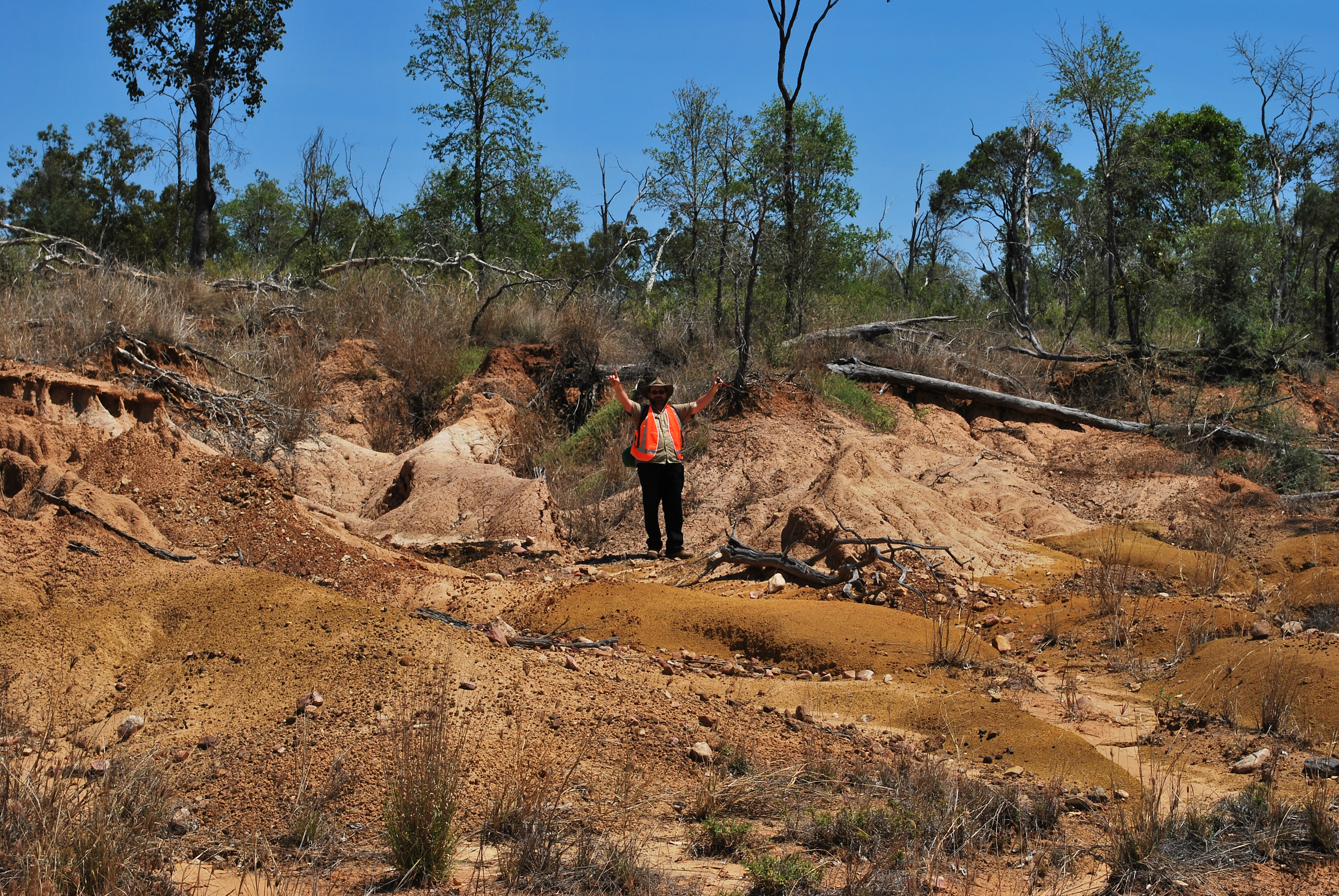
Discovery moment captured on camera. A very excited palaeontologist having stumbled upon what would turn out to be a 40,000-year-old megafauna deposit, and twelve plus years of toil.
Two sites bursting with fossil bones discovered, and the scene was set for a twelve-year long (and counting) study into what these fossils were, who they were from, how old they were and what stories they could tell about megafauna in the tropics. Now having published the first results of this study it is clear that the fossil deposits at South Walker Creek are unique not only for the types of fossils they preserve but also for the species that they represent. Unfortunately, the preservation of the remains is poor in comparison to southern Australian megafauna sites but this is not surprising because the tropical climate sees to it that fossils are rarely preserved. Because of this, we have had to extract every ounce of information from every bone, tooth and fragment, under exceptionally difficult circumstances. But thankfully we have had a couple of factors on our side that have helped preserve such a diverse range of fauna and flora.
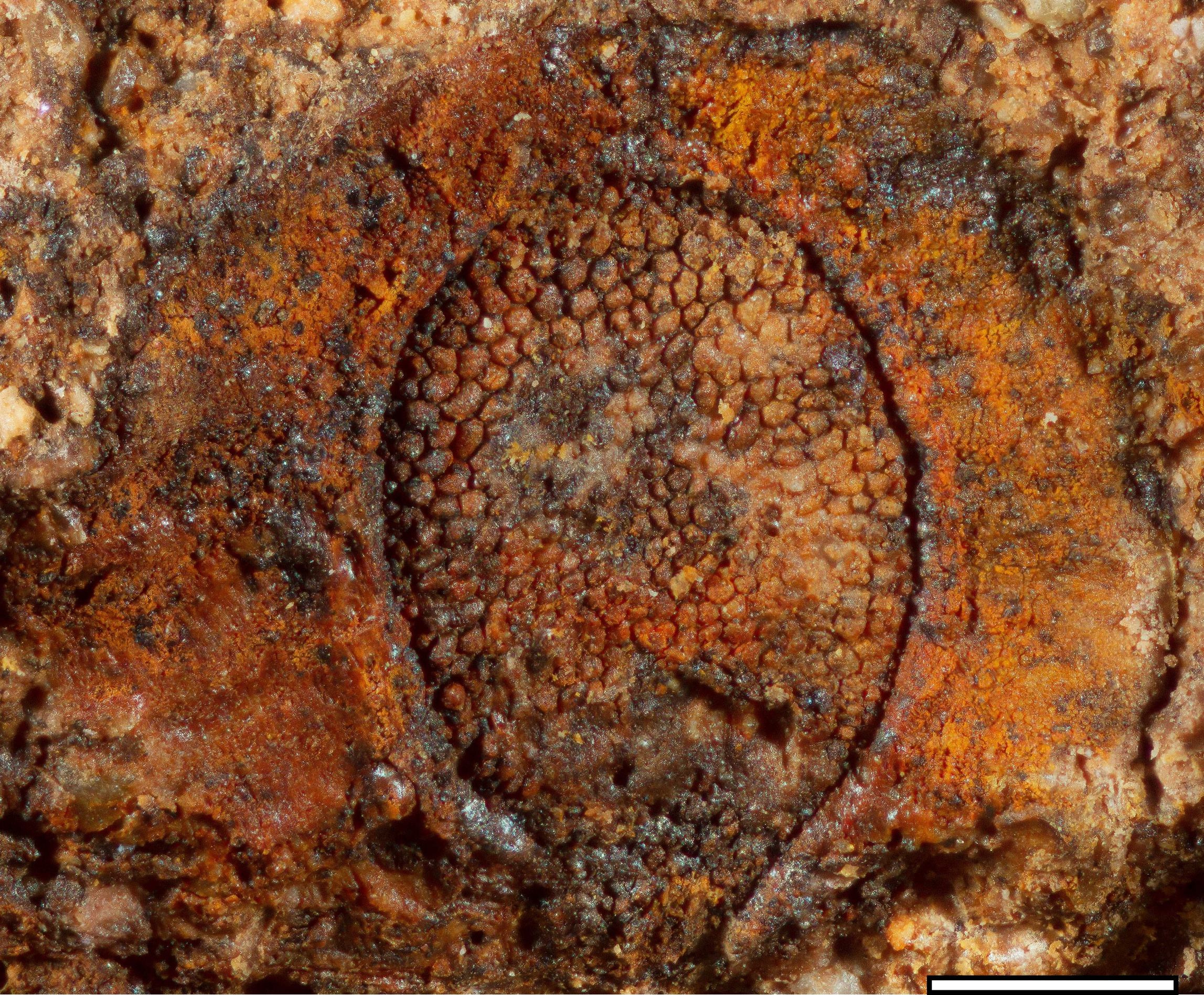
Some of the fossils found among the megafauna bones include tiny delicate leaves, seeds and insects. Here is a Goodeniaceae seed - see it in 3-D here. Image Credit: Paul Tierney
The main taphonomic factor that takes a future fossil from being alive to dead and buried fast enough to halt the hot tropical decay process are the crocodiles. Evidence of this is written across almost all of the bones via cut and puncture marks. The second major taphonomic factor that affected one site in particular, the best preserved and youngest site, was a rapid flood event. This event collected up fresh and dried skeletons, skulls and bones, insect remains, dried leaves, seeds and mollusc shells along with large cobbles and pebbles into a churning mud slurry that finally came to rest in a scoured depression on the floodplain.
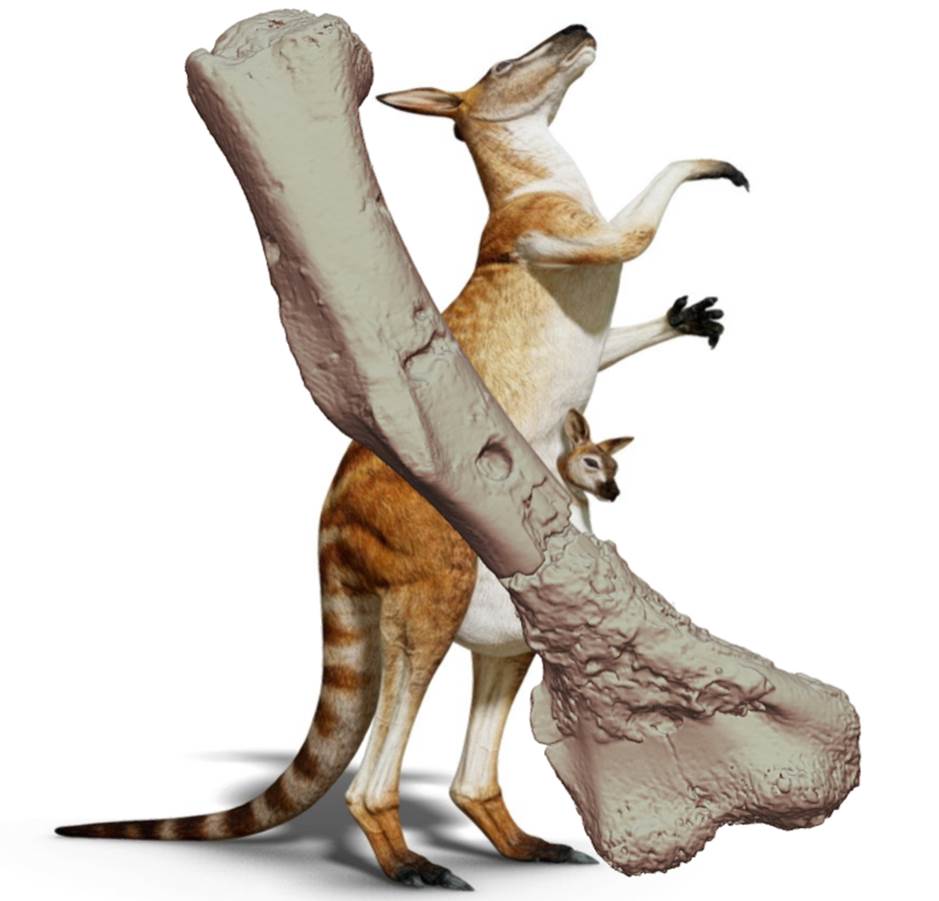
Crocodiles are the main taphonomic agents at these fossil sites. Puncture marks can be found on many of the long bones. This humerus has several along its shaft - see it in 3-D here.
Excavations at these sites over the last decade have revealed the fossil deposits and how they formed. The bone jumble of the main site, that we affectionately call QML1420 (SW9), first resembled a random assortment of bones with no associations, a crocodile ‘dinner plate’. However, we have slowly pieced together the portions of each skeleton found, including articulated and associated remains of most species. One amazing discovery in 2013 of a massive pelvis and attached tail of the giant buck-toothed wombat (Phascolonus gigas) that matched the two femora (thigh bones) from this same individual found three years previously. Since then we’ve found teeth, toe bones and parts of the skull. Such a large, flat pelvis with a thin long flimsy tail told us that the parts of this animal’s skeleton did not travel a great distance before burial, however, it likely sat out on the surface for a short time before the flood event swept it up.
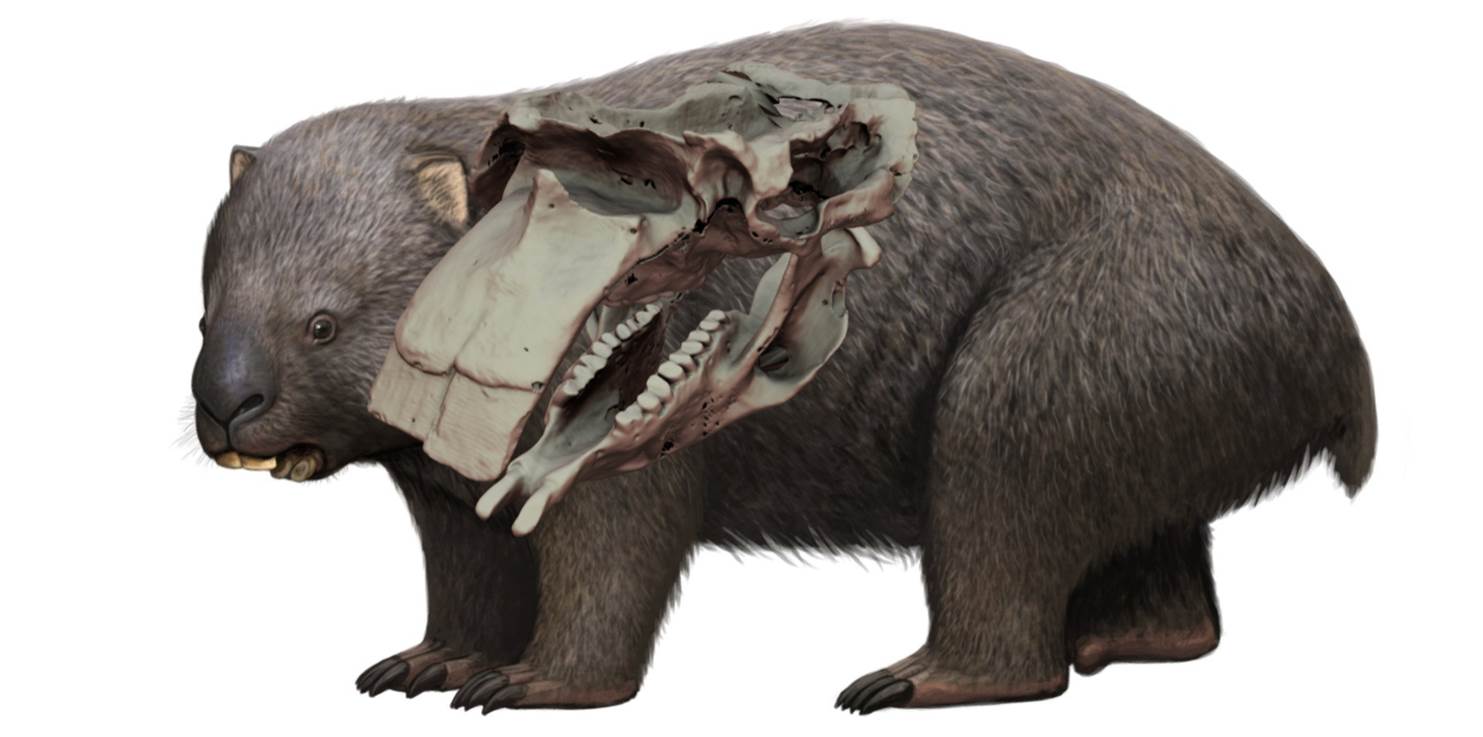
The giant buck-toothed wombat Phascolonus gigas has been found at South Walker Creek - see them 3-D here.
Similarly, the subadult Diprotodon skull I found in 2008 eventually matched a lower right jaw found in 2012, then this jaw connected to a left jaw found five years later in 2017! So for this one individual it took 9 years before we could confidently associate these bones together. This type of decade-long jigsaw puzzling was repeated for many of the species we have found and continues today in the lab. We still have hundreds of bones yet to be fully prepared and matched back with their counterparts.
Why are these sorts of decade-long jigsaws so important? Well, for one, they show that the site preserves the remains of several species and these are represented by only one or a few individuals each. Therefore, it is likely that this fossil deposit represents a snapshot of the fauna living together at the same time. It also shows that the fossils have not been eroded from older sediments and re-interred together, mixing the assemblage. With this we can be quite confident that the fauna is representative of the ecosystem of the time. To be sure, we undertook geochemical assessments of several megafauna remains, in particular their teeth, to determine whether older remains were being incorporated into this site. To our amazement the resulting assessments (by two different labs) returned very similar results and could demonstrate that there was no indication of reworking of older remains into the site. What this also meant was that the other fossils found in the site would also probably represent the environment at the time of deposition. With the unique discovery of insects, leaves and other smaller fauna, we had the start of a story that would build up to a picture for the first time of what tropical Australia was like during the last days of the megafauna.
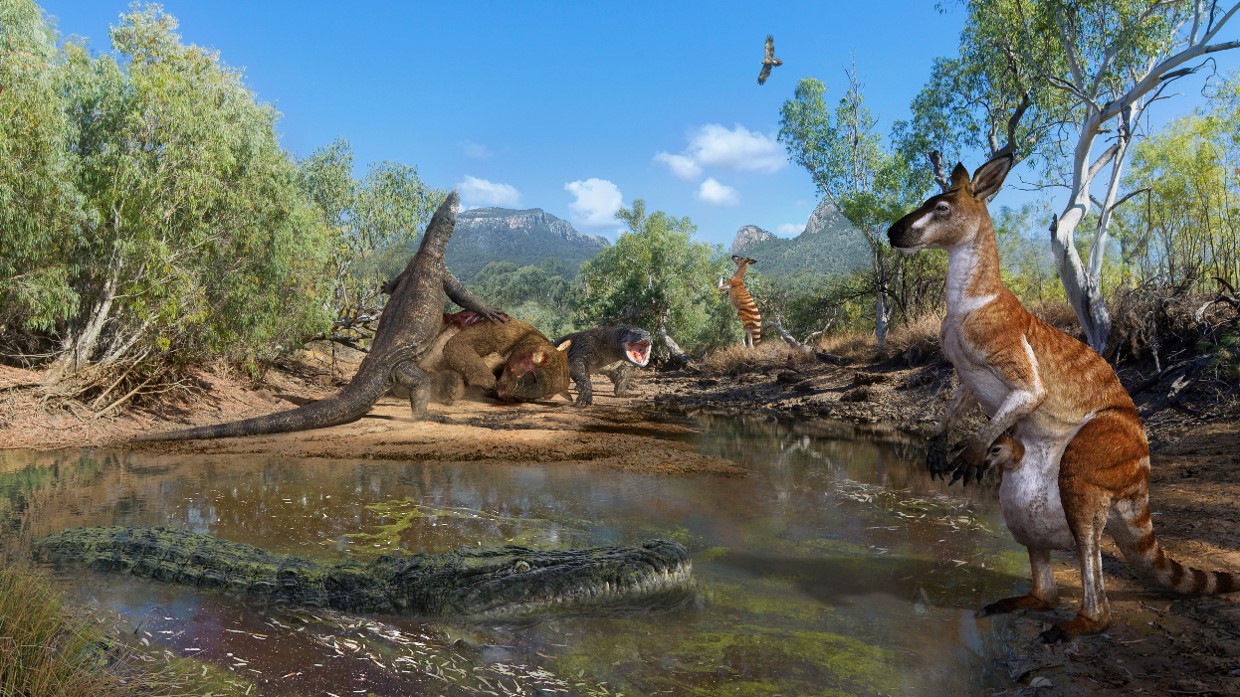
Life and Death in Tropical Australia, 40,000 years ago. Pallimnarchus stalks the world’s largest kangaroo at the edge of a drying billabong. Two Megalania fight over the carcass of Diprotodon optatum whilst another giant kangaroo, standing at 3m tall, reaches for the freshest leaves to eat. In the distance, the sun beats down on the Mt. Britton range, a silent witness to the extinctions yet to unfold. Credit: Ryan Bargiel, Vlad Konstantinov, Andrey Atuchin & Scott Hocknull © Queensland Museum (2020).
The megafauna species that have so far been discovered from the fossil sites (work is still ongoing!) include sixteen species of megafauna, including three species of living megafauna, the Emu, Saltwater Crocodile and Red Kangaroo. But for the site of our main focus, thirteen species have been found. Let’s start with the mega-plant eaters. Three species of giant extinct kangaroo have been found, including a species that is the world’s largest kangaroo. It certainly is based on linear measurements of its long bones, and with a predicted body mass estimate of around 274kg, it was enormous! Unfortunately, we do not have a complete skeleton of this species, so such body mass estimates may not be born out when better skeletons are found, but it serves as a good comparison to the former heavy-weight champion Procoptodon goliah. Based on exactly the same predictive equation Procoptodon goliah would have a body mass of approximately 250kg.
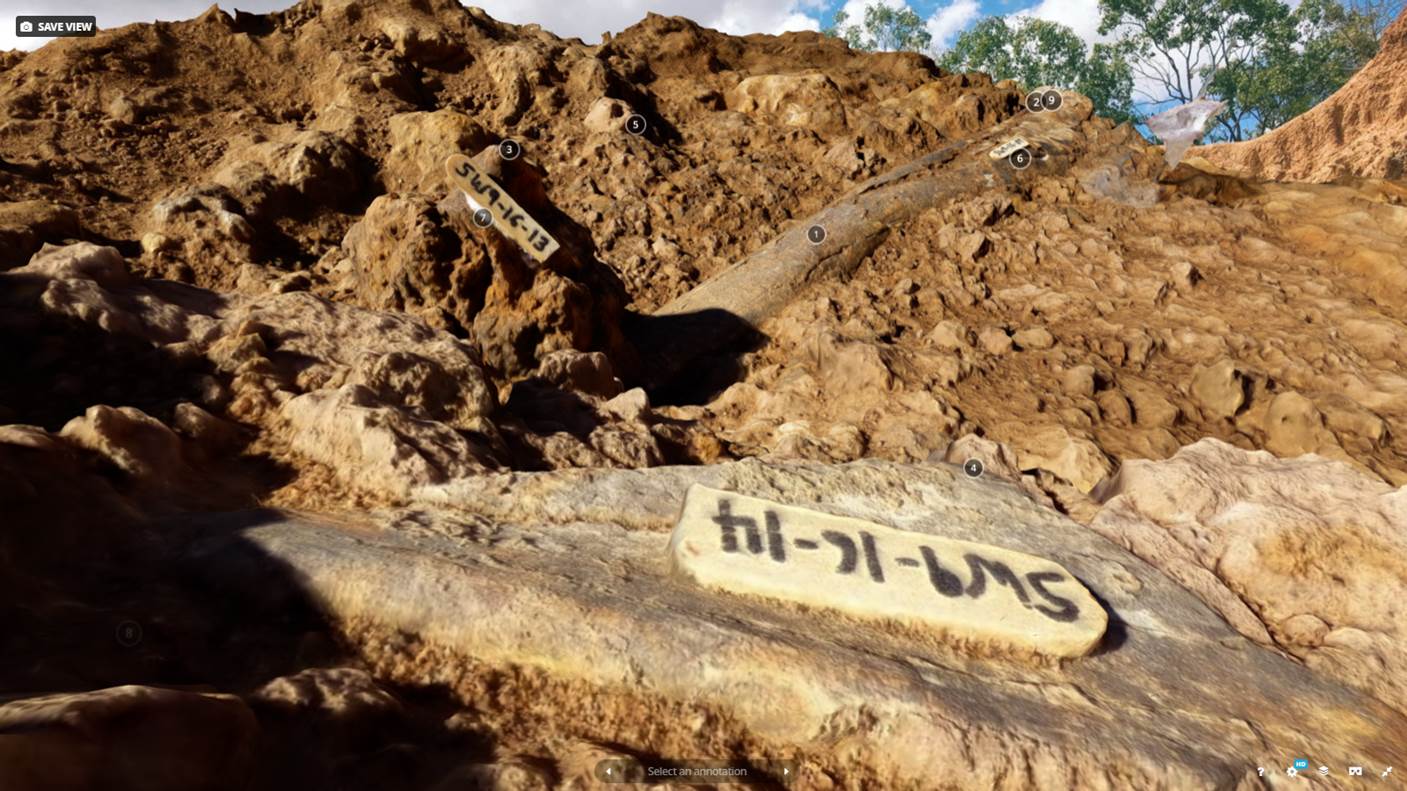
From the field, bones of the world's largest kangaroo in situ in 3-D here.
The weirdest part about our new giant kangaroo is that it is almost identical in most respects to a ‘normal’ run-of-the-mill kangaroo, like a Grey or a Red Kangaroo, just much (much) larger. Unlike Procoptodon, a massively built short-faced kangaroo, our roo was a giant species of Macropus, the genus many living species belong to. There are a couple of contenders for what species it is; however, as unlucky as the fossil record is, we do not have enough material to adequately compare. After a long sleuth through museum collections around Australia I have no definitive answer other than to say it is likely an entirely new species.
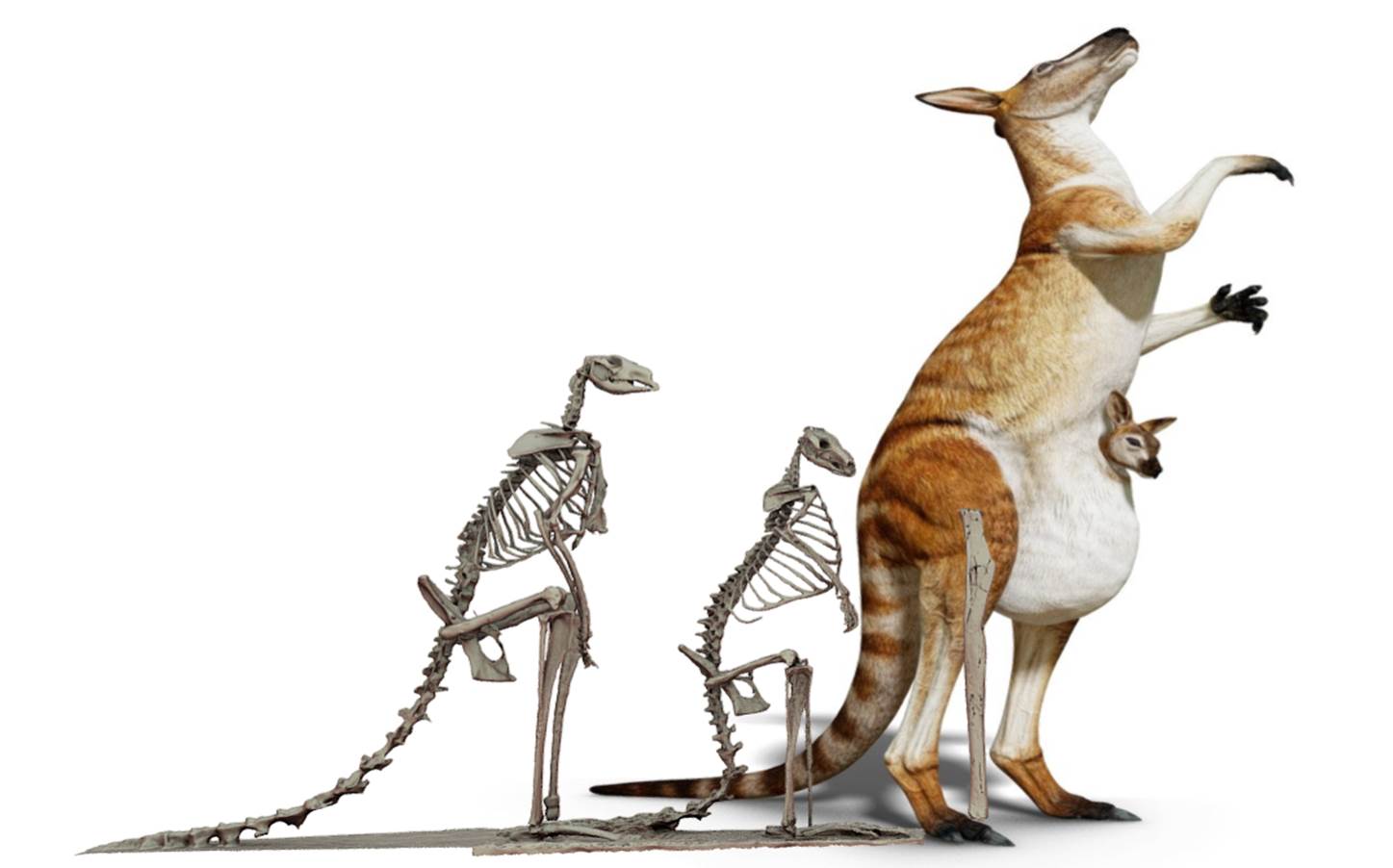
The giant extinct Macropus species next to modern Grey and Red Kangaroo - skeletons in 3-D here.
The giant kangaroos from South Walker Creek don’t easily fit into a typical Pleistocene ‘mould’. The most ubiquitous extinct giants that we should expect to find are the sthenurines (short-faced kangaroos), the giant wallaby Protemnodon anak and the giant Grey Kangaroo Macropus giganteus titan. These types of Pleistocene megafauna kangaroo are commonly found in catchments to the south and west of the Fitzroy River Basin, throughout the Murray-Darling Basin, and into central Australia. Yet we have not found a single representative of these species excepting for one quarter of one molar from a very small species of short-face kangaroo. Therefore, whatever the kangaroo ‘make-up’ of this tropical megafauna assemblage was it does not resemble in any way the kangaroo faunas from the southern and central parts of the continent. Even the small macropodoid fauna from these sites represent peculiarities not found elsewhere, but that is a story for another publication.
Along with the giant roos, the other huge herbivores included two species of extinct wombat, the giant Diprotodon and the enigmatic marsupial Palorchestes, which resembled a marsupial version of an alien-like sloth-bear! Diprotodon from these sites are peculiar relative to other specimens of Diprotodon found elsewhere, being very small in overall size but possessing proportionately very large teeth. I feel there is something odd going on with these northern populations of Diprotodon, but this is yet to be figured out. Two specimens show excessive tooth wear suggesting either a very small-sized and old individual, or a small individual that had been munching on very nutritionally poor abrasive vegetation. Are these indications of megafauna under environmental stress toward their demise?
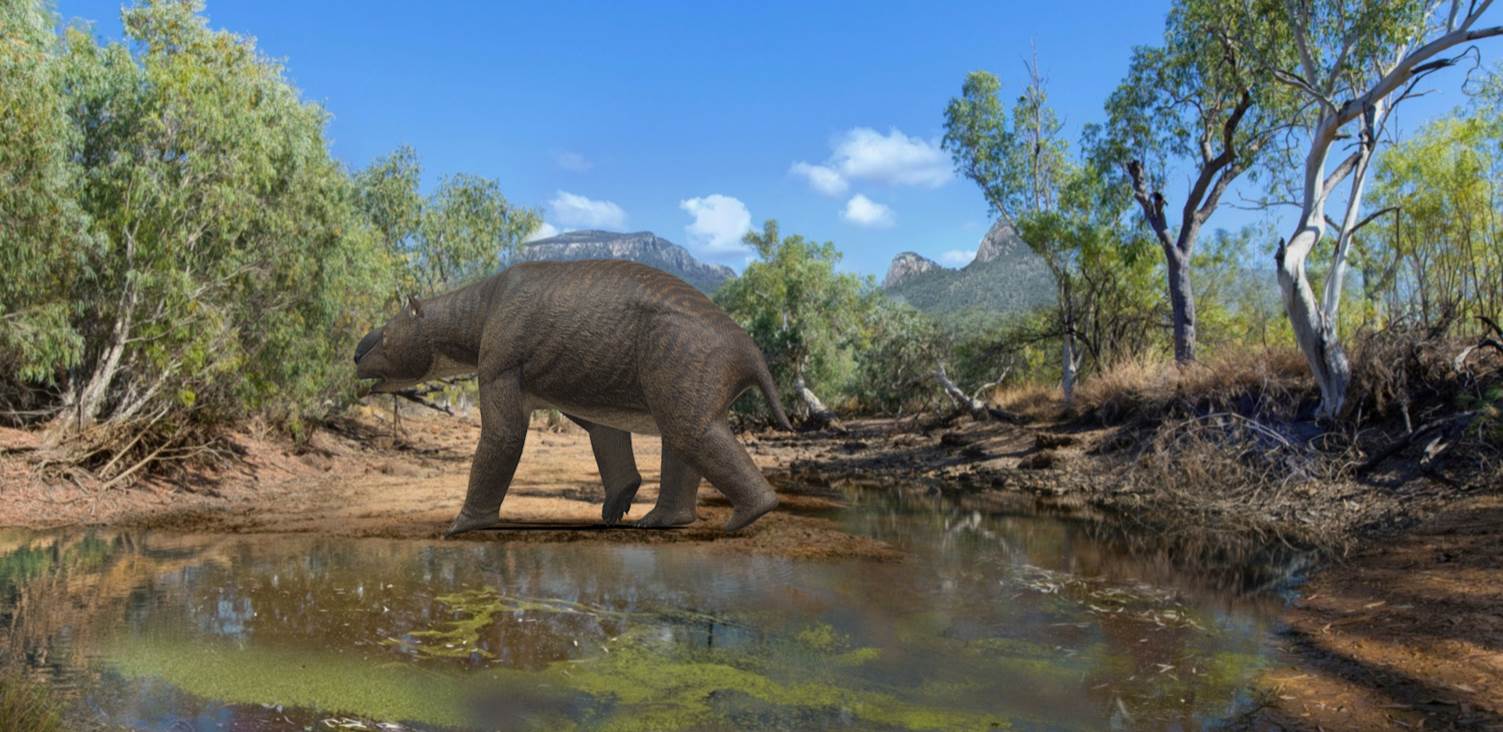
An environment under stress? A drying billabong attracts a lone Diprotodon - 3-D model here
One exciting discovery, that will form part of a future work, was the discovery in one of the giant Macropus individuals of a very peculiar and undiagnosed pathology. The best-preserved tibia (shin bone) of this giant kangaroo species has within its mid-shaft an obvious and quite alarming osteological pathology. Along one side of the bone there is a deep invagination within the bone and around this there is a lot of secondary bone growth. This clearly shows that the animal did not die from this pathology or associated disease but survived it and continued on living, and presumably using its legs in locomotion. The pathology is very strange and we are working with X-ray Computed Tomography scans of this bone to decipher what sort of pathology this bone had and what this meant for the animal’s life history. The epiphyses are not fused at the ends of this long bone, suggesting that it was still growing, although we know species of Macropus continue to grow as adults, especially in their limbs. The most intriguing question surrounding this diseased giant kangaroo is whether it was functionally able to hop, even as a healthy animal. It is simple too big and heavy to hop if our current understanding of kangaroo hopping biomechanics is correct. If it did hop, did this disease for this individual impact upon the animal’s ability to move? Perhaps surviving a disease of the leg lends itself to the not-hopping hypothesis. Either way, two tell-tale puncture marks found at the proximal end of the tibia tell of this individual’s last moments. Although this giant of its time survived a diseased leg it succumbed to the attack of a monstrous crocodile. Well that’s what life and death in the tropics 40,000 years ago will do to you!
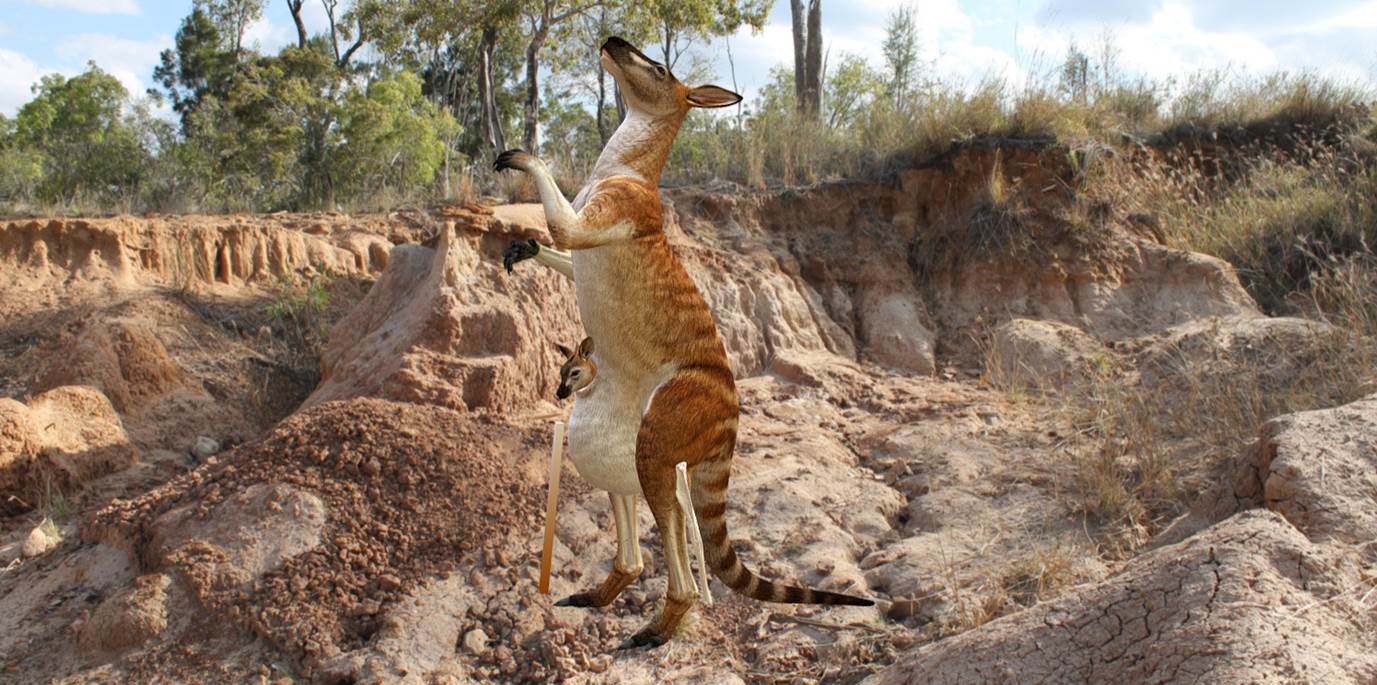
Could it have hopped? The giant species of Macropus seems to defy current biomechanical models. 1m stick for scale. See the 3-D model here.
Throughout the years of excavation, we have wondered what, if any, evidence we might find to indicate a presence of people during the time of the megafauna. Initially there were some possibilities but these were not convincing, so over the course of the study with more sediment excavated, sieved and sorted, with more bones prepared and more sites uncovered, we have become increasingly certain that finding direct evidence of a human record at our sites is highly unlikely. But we continue to wonder whether people were in the environment at the time of our megafauna. This all boils down to whether it is possible for people, having arrived onto the continent 50,000-65,000 years ago to have dispersed to South Walker Creek before the time our fossil sites were formed. Perhaps people were in the environment, but simply left no distinct record on the flood plains where the fossils were preserving. Of course these are all open-ended thought bubbles, without evidence to go on. So we must assume they were not in the environment, or if they were, at such low population densities not to leave a distinct line of evidence at our sites. We are going to approach this question in the future, coming at it from different angles and using a range of palaeoenvironmental tools.
Thinking more broadly about the implications of our study, the fossil evidence demonstrates a diverse range of species, and frankly several that if you were to meet them today would be absolutely terrifying! This above all else in the story of Australian megafauna is what sparks my (child-like) imagination most. With the timing of occupation of northern Australia clearly overlapping megafauna species by some 25,000 years (give or take), what was it like to first meet the megafauna? No doubt this likely occurred a long way away, and before the megafauna at South Walker Creek died out, but if the diversity of species found at South Walker Creek between 60,000 and 40,000 years ago is representative of the megafauna species people first met I am left wondering what their initial impressions would have been.
This is where the story of tropical Australian megafauna is somewhat unique relative to megafauna elsewhere in Australia and certainly unique globally. We can confidently place four or perhaps five mega-reptile predators in the environment, including two aquatic crocodilians, one terrestrial (or semi-terrestrial) crocodilian and two giant goannas! Having personally come up close to and fed both the largest living lizard (Komodo Dragon) and the largest living aquatic reptile (Saltwater Crocodile) you quickly develop a respectful fear of them and a significant appreciation of them as apex predators. Now consider five different species of apex predatory reptile, with one a 5-6m long version of the Komodo Dragon, dominating the tropical Australian environment during the Pleistocene.
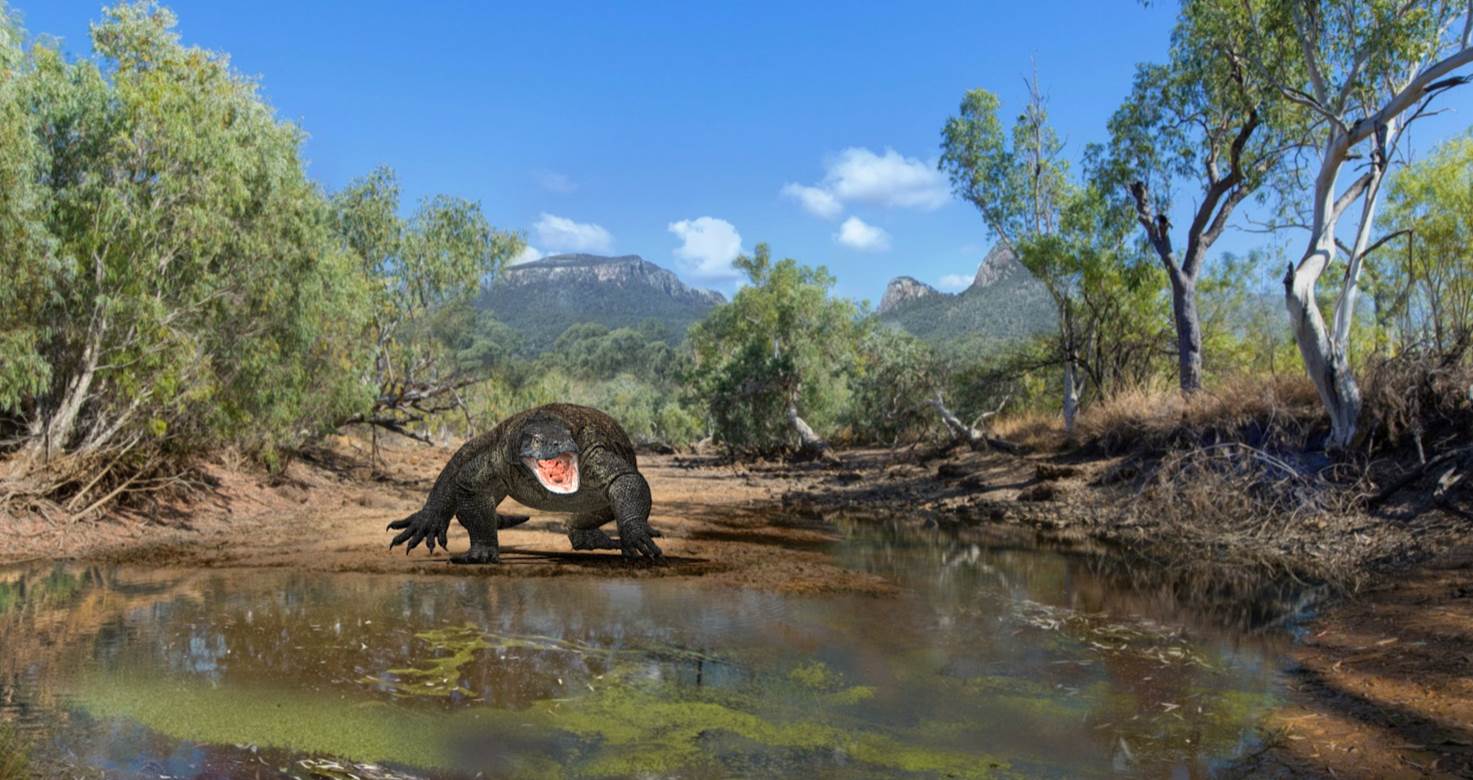
The Sahul 'special', the giant 6m long goanna Megalania, the largest terrestrial reptile since the time of the dinosaurs. 3-D model here
These giant terrestrial reptiles are the largest predatory reptiles to inhabit the Earth since the extinction of the dinosaurs. Each species had a body covering of bone and scale armour, thick and interlocked like chain-mail or scale-mail. All species were armed with dozens of teeth, some bladed and serrated, and all possessed muscular tails. This doesn’t sound like your typical Pleistocene megafauna site from North America or Europe. The diversity of crocodiles might resemble some sites from Africa and South America, but the giant lizards, that’s a Sahul special!
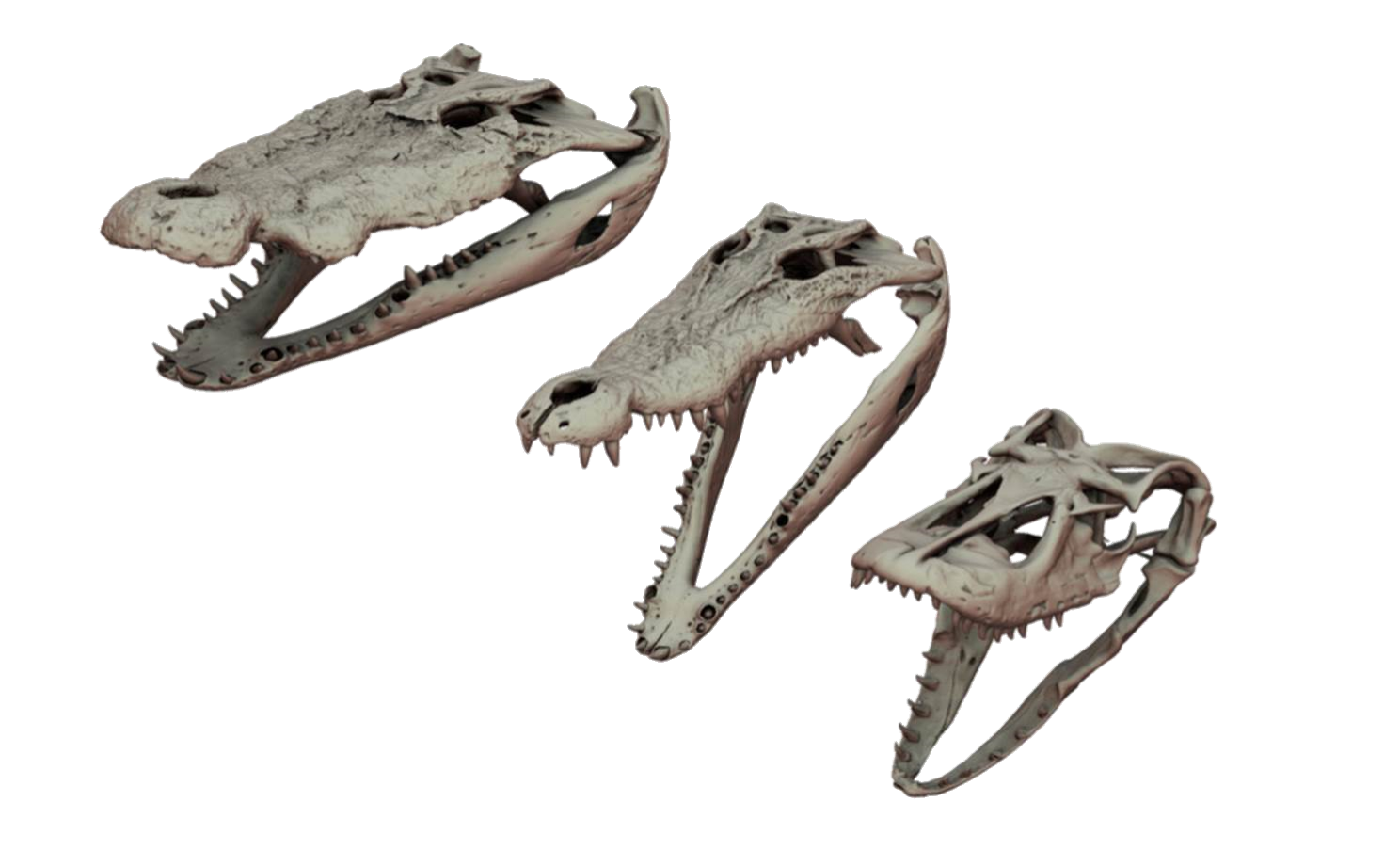
Mega-predators of the tropical Sahul 60,000-40,000 years ago were dominated by reptiles, including the broad-snouted Pallimnarchus (left), Saltwater crocodile (centre) and Megalania (right). Compare in 3-D here.
The apex predators were mostly reptiles, however, we have found both direct and indirect evidence of the most formidable meat-eating marsupial, Thylacoleo or ‘Pouched Lion’. This predator with its meat and bone cleaving teeth, muscular forearms and grappling paws would resemble no animal found anywhere else on Earth. Bones from the South Walker Creek site show the trademark cut-marks from a Thylacoleo, but one bone in particular records a very peculiar style of bone processing. This too is another story for another time, but it goes to show that the environment at South Walker Creek possessed as many as six apex predators, mostly reptiles with one unbelievably strange mammalian carnivore. Top this off with gigantic bipedal kangaroos and truly bizarre giant wombat-sloth-bear like marsupials, you have a mix of fauna the beggar belief. So, for as much as we debate the extinction of these creatures and the roles of environmental change and humans we cannot deny the fact that the Australian megafauna were globally unique, adapted to a continent in isolation and their stories are not even close to being fully told.
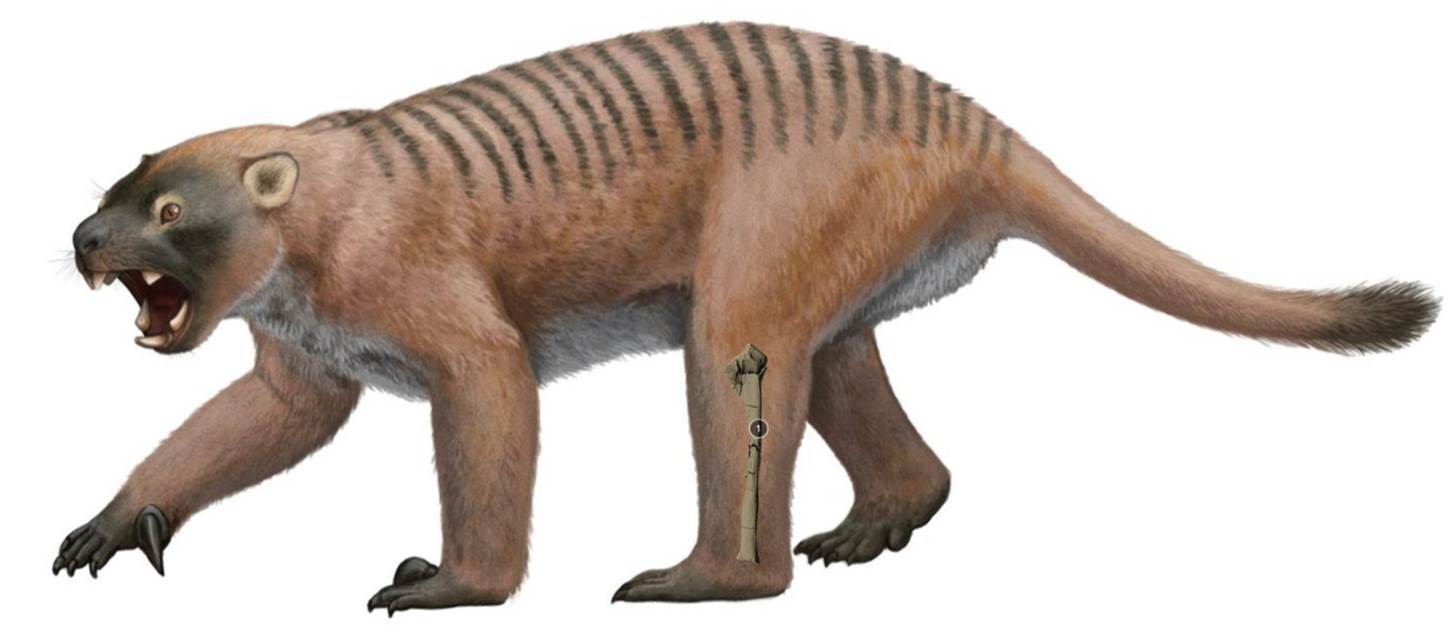
Not to be outdone by the reptiles, tropical Australia was also home to a lion-sized marsupial carnivore, Thylacoleo. See bones from South Walker Creek in 3-D here.
Read the Nature Communications publication Extinction of eastern Sahul megafauna coincides with sustained environmental deterioration by Hocknull et al. 2020.
Check out behind the science in 3-D at Queensland Museum on sketchfab.
Follow the Topic
-
Nature Communications

An open access, multidisciplinary journal dedicated to publishing high-quality research in all areas of the biological, health, physical, chemical and Earth sciences.
Related Collections
With Collections, you can get published faster and increase your visibility.
Women's Health
Publishing Model: Hybrid
Deadline: Ongoing
Advances in neurodegenerative diseases
Publishing Model: Hybrid
Deadline: Dec 24, 2025
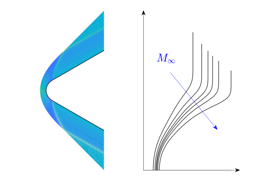
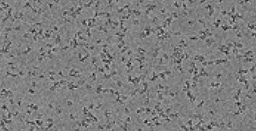
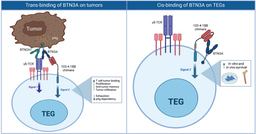


Please sign in or register for FREE
If you are a registered user on Research Communities by Springer Nature, please sign in